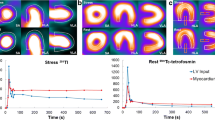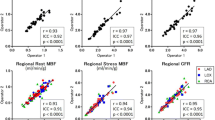Abstract
Background
Myocardial perfusion single photon emission computed tomography (SPECT) occasionally fails to detect coronary stenosis in patients with coronary artery disease (CAD). We evaluated coronary flow reserve (CFR) using oxygen 15-labeled water in areas with and without ischemia on technetium 99m tetrofosmin stress perfusion SPECT in patients with angiographically documented CAD.
Methods and Results
Twenty-seven patients with CAD and eleven age-matched normal subjects were studied. Baseline myocardial blood flow (MBF) and MBF during hyperemia induced by intravenous adenosine triphosphate infusion (0.16 mg · kg-1 · min-1) were determined with the use of O-15-labeled water positron emission tomography, and the CFR was calculated. Tc-99m tetrofosmin stress/rest SPECT was performed for comparison. On the basis of the results of coronary angiography and SPECT, coronary segments were divided into 3 types: segments with coronary stenosis and a perfusion abnormality on stress SPECT imaging (group A, n = 16), segments with coronary stenosis without a perfusion abnormality (group B, n = 42), and remote segments with no coronary stenosis or perfusion abnormality (group C, n = 18). Baseline MBF values were similar among the 3 groups. CFR in group A was lower (1.82 ± 0.54) than in group B (2.22 ± 0.87, P < .05), in group C (2.92 ± 1.21, P < .01), and in normal segments (3.86 ± 1.24, P < .001). CFR in group B was lower than in group C (P < .02) and in normal segments (P < .001). CFR in group C was lower than in normal segments (P < .02).
Conclusions
Areas with a perfusion abnormality on stress SPECT had reduced CFR. In the areas without a perfusion abnormality and with coronary stenosis, lowering of CFR was intermediate between the areas with a perfusion abnormality and remote segments. Moreover, CFR was slightly, but significantly, lower in remote segments in patients with CAD compared with normal segments.
Similar content being viewed by others
References
White CW, Wright CB, Doty DB, et al. Does visual interpretation of the coronary arteriogram predict the physiologic importance of a coronary stenosis? N Engl J Med 1984;310:819–24.
Marcus ML, Skorton DJ, Johnson MR, et al. Visual estimates of percent diameter coronary stenosis: a battered gold standard. J Am Coll Cardiol 1988;11:882–5.
Vogel RA. Assessing stenosis significance by coronary arteriography: are the best variables good enough? J Am Coll Cardiol 1988;12:692–3.
Gill JB, Ruddy TD, Newell JB, et al. Prognostic importance of thallium uptake by the lungs during exercise in coronary artery disease. N Engl J Med 1987;317:1485–9.
Weiss AT, Berman DS, Lew AS, et al. Transient ischemic dilatation of the left ventricle on stress thallium-201 scintigraphy: a marker of severe and extensive coronary artery disease. J Am Coll Cardiol 1987;9:752–9.
Iskandrian AS, Chae SC, Heo J, et al. Independent and incremental prognostic value of exercise single-photon emission computed tomographic (SPECT) thallium imaging in coronary artery disease. J Am Coll Cardiol 1993;22:665–70.
Abdulla A, Maddahi J, Garcia E, et al. Slow regional clearance of myocardial thallium-201 in the absence of perfusion defect; its contribution to detection of individual coronary artery stenosis and mechanisms for its occurrence. Circulation 1985;71:72–9.
Doucette JW, Corl PD, Payne HM, et al. Validation of a Doppler guide wire for intravascular measurement of coronary artery flow velocity. Circulation 1992;85:1899–911.
Redberg RF, Sobol Y, Chou TM, et al. Adenosine-induced coronary vasodilation during transesophageal Doppler echocardiography rapid and safe measurement of coronary flow reserve ratio can predict significant left anterior descending coronary stenosis. Circulation 1995;92:190–6.
Hozumi T, Yosida K, Ogata Y, et al. Noninvasive assessment of coronary flow velocity and coronary flow velocity reserve in the left anterior descending coronary artery by Doppler echocardiography. Circulation 1998;97:1557–62.
Uren NG, Melin JA, De Bruyne B, et al. Relation between myocardial blood flow and the severity of coronary artery stenosis. N Engl J Med 1994;330:1782–8.
Uren NG, Crake T, Lefroy DC, et al. Reduced coronary vasodilator function infarcted and normal myocardium after myocardial infarction. N Engl J Med 1994;331:222–7.
Gould K, Kirkeeide RL, Buchi M. Coronary flow reserve as a physiologic measure of stenosis severity. J Am Coll Cardiol 1990;15:459–74.
DiCarli M, Czernin J, Hoh CK, et al. Relationship among stenosis severity, myocardial blood flow, and flow reserve in patients with coronary artery disease. Circulation 1995;91:1944–51.
Henze E, Huang SC, Ratib O, et al. Measurement of regional tissue and blood-pool radiotracer concentrations from serial tomographic images of the heart. J Nucl Med 1983;24:987–96.
Iida H, Rhodes CG, de Silva R, et al. Myocardial tissue fractioncorrection for partial volume effects and measure of tissue viability. J Nucl Med 1991;32:2169–75.
Yokoyama I, Momomura S, Ohtake T, et al. Reduced myocardial flow reserve in non-insulin-dependent diabetes mellitus. J Am Coll Cardiol 1997;30:1472–7.
Laine H, Raitakari OT, Niinikoski H, et al. Early impairment of coronary flow reserve in young men with borderline hypertension. J Am Coll Cardiol 1998;32:147–53.
Yokoyama I, Ohtake T, Momomura S, et al. Reduced coronary flow reserve in hypercholesterolemic patients without overt coronary stenosis. Circulation 1996;94:3232–8.
Stewart R, Schwaiger M, Molina E, et al. Comparison of rubidium- 82 positron emission tomography and thallium-201 SPECT imaging for detection of coronary artery disease. Am J Cardiol 1991;67:1303–10.
Go RT, Marwick TH, MacIntyre WJ, et al. A prospective comparison of rubidium-82 PET and thallium-201 SPECT myocardial perfusion imaging utilizing a single dipyridamole stress in the diagnosis of coronary artery disease. J Nucl Med 1990;31:1899- 905.
Katoh C, Ruotsalainen U, Laine H, et al. Iterative reconstruction based on median root prior in quantification of myocardial blood flow and oxygen metabolism. J Nucl Med 1999;40:862–7.
Cerqueira MD, Verani MS, Schwaiger M, Heo J, Iskandrian AS. Safety profile of adenosine stress perfusion imaging: results from the Adenosine Multicenter Trial Registry. J Am Coll Cardiol 1994;23:384–9.
Watanabe K, Sekiya M, Ikeda S, et al. Comparison of adenosine triphosphate and dipyridamole in diagnosis by thallium-201 myocardial scintigraphy. J Nucl Med 1997;38:577–81.
Camici P, Marraccini P, Marzilli M, et al. Coronary hemodynamics and myocardial metabolism during and after pacing stress in normal humans. Am J Physiol 1989;257:E309–17.
Czenin J, Muller P, Chan S, et al. Influence of age and hemodynamics on myocardial blood flow and flow reserve. Circulation 1993;88:62–9.
Marinho NVS, Keogh BE, Costa DC, et al. Pathophysiology of chronic left ventricular dysfunction; new insights from the measurement of absolute myocardial blood flow and glucose utilization. Circulation 1996;93:737–44.
Schiller NB, Shah PM, Crawford M, et al. Recommendations for quantitation of the left ventricle by two-dimensional echocardiography. American Society of Echocardiography Committee on Standards, Subcommittee on Quantitation of Two-Dimensional Echocardiograms. J Am Soc Echocardiogr 1989;5:358–67.
Segar DS, Brown SE, Sawada SG, Ryan T, Feigenbaum H. Dobutamine stress echocardiography: correlation with coronary lesion severity as determined by quantitative angiography. J Am Coll Cardiol 1992;19:1197–202.
Rimoldi O, Burns SM, Rosen SD, et al. Measurement of myocardial blood flow with positron emission tomography before and after transmyocardial laser revascularization. Circulation 1999; 100(Suppl II):134–8.
Yoshinaga K, Morita K, Yamada S, et al. Low-dose dobutamine electrocardiograph-gated myocardial SPECT for identifying viable myocardium: comparison with dobutamine stress echocardiography and PET. J Nucl Med 2001;42:838–44.
Keane D, Haase J, Slager CJ, et al. Comparative validation of quantitative coronary angiography systems: results and implications from a multicenter study using a standardized approach. Circulation 1995;91:2174–83.
Merlet P, Mazoyer B, Hittinger L, et al. Assessment of coronary reserve in man: comparison between positron emission tomography with oxygen-15-labeled water and intracoronary Doppler technique. J Nucl Med 1993;34:1899–904.
De Bruyne B, Baudhuin T, Melin JA, et al. Coronary flow reserve calculated from pressure measurements in humans. Validation with positron emission tomography. Circulation 1994;89:1013–22.
Miller DD, Donohue TJ, Younis LT, et al. Correlation of pharmacological Tc-99m sestamibi myocardial perfusion imaging with poststenotic coronary flow reserve in patients with angiographically intermediate coronary artery stenoses. Circulation 1994;89:2150–60.
Joye JD, Schulman DS, Do DL, et al. Intracoronary Doppler guide wire versus single-photon emission computed tomographic thallium- 201 imaging in assessment of intermediate coronary stenosis. J Am Coll Cardiol 1994;24:940–7.
Glover DK, Ruiz M, Edwards NC, et al. Comparison between 201Tl and 99mTc sestamibi uptake during adenosine-induced vaso- dilation as a function of coronary stenosis severity. Circulation 1995;91:813–20.
Glover DK, Ruiz M, Yang JY, et al. Myocardial 99mTc-tetrofosmin uptake during adenosine-induced vasodilation with either a critical or mild coronary stenosis. Comparison with 201Tl and regional myocardial blood flow. Circulation 1997;96:2332–8.
Glover DK, Okada RD. Myocardial kinetics of Tc-MIBI in canine myocardium after dipyridamole. Circulation 1990;81:628–36.
Sinusas AJ, Shi QX, Saltzberg MT, et al. Technetium-99m tetrofosmin to assess myocardial blood flow: experimental validation in an intact canine model of ischemia. J Nucl Med 1994;35:664–71.
Araujo LI, Lammerstma AA, Rhodes CG, et al. Noninvasive quantification of regional myocardial blood flow in coronary artery disease with oxygen-15-labeled carbon dioxide inhalation and positron emission tomography. Circulation 1991;83:875–85.
Serruys PW, Mario CD, Piek J, et al. Prognostic value of intracoronary flow velocity and diameter stenosis in assessing the short and long-term outcomes of coronary balloon angioplasty: the DEBATE study (Doppler Endpoints Balloon Angioplasty Trial Europe). Circulation 1997;96:3369–77.
Bateman TM. Clinical relevance of a normal myocardial scintigraphic study: American Society of Nuclear Cardiology. J Nucl Cardiol 1997;4:172–3.
Pamelia FX, Gilson RS, Watson PD, et al. Prognosis with chest pain and normal thallium-201 exercise scintigrams. Am J Cardiol 1992;55:920–6.
Uren NG, Marraccini P, Gistri R, et al. Altered coronary vasodilator reserve and metabolism in myocardium subtended by normal arteries in patients with coronary artery disease. J Am Coll Cardiol 1993;22:650–8.
Iida H, Rhodes CG, Araujo LI, et al. Noninvasive quantification of regional myocardial metabolic rate for oxygen by use of 15O2inhalation and positron emission tomography: theory, error analysis, and application in humans. Circulation 1996;94:792- 807.
Wisenberg G, Schelbert HR, Hoffman EJ, et al. In vivo quantitation of regional myocardial blood flow by positron-emission computed tomography. Circulation 1981;63:1248–58.
de Silva R, Camici PG. The role of positron emission tomography in the investigation of coronary circulatory function in man. Cardiovasc Res 1994;28:1595–612.
Gupta NC, Esterbrooks DJ, Hilleman DE, Mohiuddin SM. Comparison of adenosine and exercise thallium-201 single photon emission computed tomography (SPECT) myocardial perfusion imaging. J Am Coll Cardiol 1992;19:248–57.
Kaufmann PA, Gnecchi-Ruscone T, Yap JT, Rimoldi O, Camici G. Assessment of the reproducibility of baseline and hyperemic myocardial blood flow measurements with 1502 labeled water and PET. J Nucl Med 1999;40:1848–56.
Walsh MN, Geltman EM, Steele RL, et al. Augmented myocardial perfusion reserve after angioplasty quantified by positron emission tomography with H2 15O. J Am Coll Cardiol 1990;15:119–27.
Author information
Authors and Affiliations
Corresponding author
Rights and permissions
About this article
Cite this article
Yoshinaga, K., Katoh, C., Noriyasu, K. et al. Reduction of coronary flow reserve in areas with and without ischemia on stress perfusion imaging in patients with coronary artery disease: A study using oxygen 15-labeled water PET. J Nucl Cardiol 10, 275–283 (2003). https://doi.org/10.1016/S1071-3581(02)43243-6
Received:
Accepted:
Issue Date:
DOI: https://doi.org/10.1016/S1071-3581(02)43243-6




